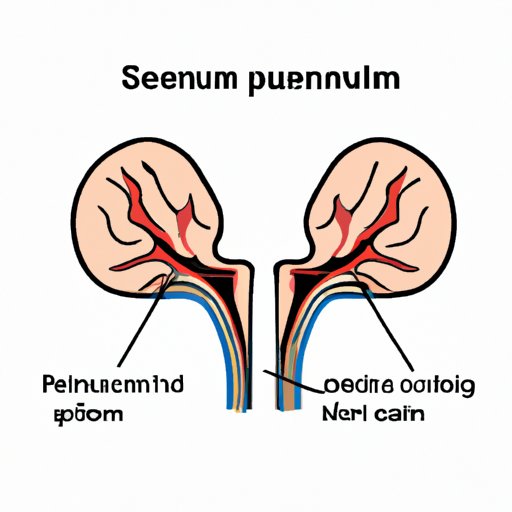I. Introduction
Understanding the anatomy of the brain is crucial for a variety of reasons. It can help you comprehend how the brain functions, allow you to understand different brain-related conditions and provide insight on how to prevent or treat these conditions. One aspect of brain anatomy that’s particularly noteworthy is the septum pellucidum. This structure divides the brain’s ventricles, which are responsible for the production and circulation of cerebrospinal fluid. If you have a condition related to this structure, understanding how the septum pellucidum divides the ventricles can help you better understand your treatment options. This article provides a comprehensive guide to the ventricles divided by the septum pellucidum, including their anatomy, importance, and associated conditions.
II. Anatomy 101: The Ventricles Divided by the Septum Pellucidum
The ventricles are a network of interconnected chambers within the brain that produce, circulate, and absorb cerebrospinal fluid. Each hemisphere of the brain comprises of a lateral ventricle that’s divided into anterior horn, body, and posterior horn. The third ventricle is situated in the midline of the brain and is connected to the fourth ventricle via the cerebral aqueduct. The fourth ventricle is located in the brainstem, between the cerebellum and the brainstem. The septum pellucidum is a thin membrane located in the midline of the brain and is responsible for dividing the lateral ventricles.
III. Understanding Brain Structures: The Septum Pellucidum Divides Which Ventricles?
The septum pellucidum is specifically responsible for dividing the lateral ventricles into left and right sections. It is positioned between the corpus callosum and the fornix, and it’s an important structure in the brain’s ventricular system. The lateral ventricles are instrumental in the production, circulation, and absorption of cerebrospinal fluid, an essential component in brain function.
IV. The Link Between the Septum Pellucidum and Lateral Ventricles
The lateral ventricles comprise the majority of the ventricular system and are linked to the third ventricle via the interventricular foramen. These structures play an essential role in maintaining the overall fluid balance in the brain. Cerebrospinal fluid produced in the lateral ventricles is circulated across the brain and the spinal cord, providing nutrients and removing waste products along the way.
V. The Significance of the Septum Pellucidum in the Human Brain
The septum pellucidum is involved in several essential functions within the brain. It provides structural support and helps maintain the proper fluid balance within the ventricular system. Disruptions of this balance can cause several symptoms ranging from headaches to severe neurological conditions. Problems associated with the septum pellucidum can also have a significant impact on other brain structures and functions. Conditions such as hydrocephalus, acquired immunodeficiency syndrome, and spina bifida are often associated with septum pellucidum-related problems.
VI. Exploring the Role of the Septum Pellucidum in Cerebrospinal Fluid Circulation
Cerebrospinal fluid, produced in the lateral ventricles, travels through the brain and spinal cord, supplying nutrients and removing waste products. The septum pellucidum helps regulate this circulation by dividing the lateral ventricles into left and right sections. This division ensures that cerebrospinal fluid flows along the correct pathways and toward the correct structures to maintain the proper fluid balance.
VII. A Comprehensive Guide to the Ventricles Divided by the Septum Pellucidum
Understanding the septum pellucidum’s role in dividing the brain’s ventricles and the importance of the ventricular system is crucial in comprehending brain-related conditions and their treatment. By understanding the anatomy, physiology and pathology surrounding the septum pellucidum, individuals with related conditions can make more informed decisions about their care. Regular neuro-visits can help identify issues early on and proper regimen can be started to treat them at the beginning stage.
VIII. How the Septum Pellucidum Divides Your Brain’s Ventricles
The septum pellucidum is a delicate yet crucial structure that helps regulate the proper functioning of the ventricular system in the brain. Understanding its anatomy and role in cerebrospinal fluid circulation can help you appreciate the structure’s importance and the impact of associated conditions. By consulting with a neurologist and taking a proactive approach to brain health, you can ensure that you’re taking the necessary steps to maintain optimal brain health.
